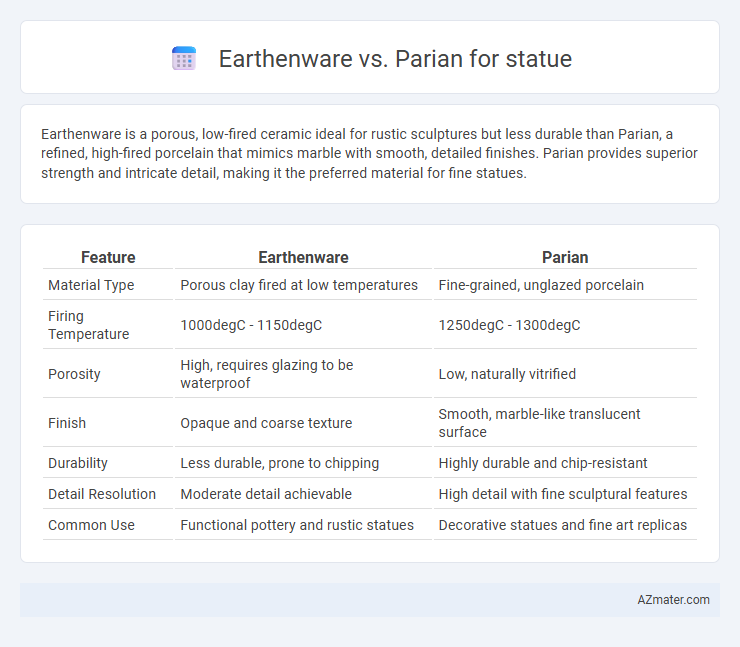Earthenware is a porous, low-fired ceramic ideal for rustic sculptures but less durable than Parian, a refined, high-fired porcelain that mimics marble with smooth, detailed finishes. Parian provides superior strength and intricate detail, making it the preferred material for fine statues.
Table of Comparison
| Feature | Earthenware | Parian |
|---|---|---|
| Material Type | Porous clay fired at low temperatures | Fine-grained, unglazed porcelain |
| Firing Temperature | 1000degC - 1150degC | 1250degC - 1300degC |
| Porosity | High, requires glazing to be waterproof | Low, naturally vitrified |
| Finish | Opaque and coarse texture | Smooth, marble-like translucent surface |
| Durability | Less durable, prone to chipping | Highly durable and chip-resistant |
| Detail Resolution | Moderate detail achievable | High detail with fine sculptural features |
| Common Use | Functional pottery and rustic statues | Decorative statues and fine art replicas |
Introduction to Earthenware and Parian Statues
Earthenware statues are crafted from porous clay fired at lower temperatures, resulting in a durable yet slightly porous material favored for its rustic texture and affordability. Parian statues, made from refined porcelain-like bisque, mimic the appearance of marble with a smooth, translucent surface ideal for detailed sculptures and high-end decorative pieces. Both materials offer unique aesthetic and tactile qualities, with earthenware emphasizing warmth and earthiness, while Parian highlights elegance and fine detail.
Historical Background of Earthenware and Parian
Earthenware, with origins tracing back to prehistoric times, was one of the earliest materials used for crafting statues due to its availability and ease of shaping; it is characterized by a porous texture and fired at lower temperatures, resulting in a durable but less refined finish. Parian ware emerged in the 19th century as a type of biscuit porcelain developed in England, designed to imitate the smooth, white marble of Paros, providing a more refined and detailed surface ideal for neoclassical statue reproduction. The historical significance of earthenware lies in its role in ancient civilizations for utilitarian and artistic purposes, while Parian represents the industrial advancement in ceramic techniques during the Victorian era focused on aesthetic elegance.
Material Composition: Earthenware vs Parian
Earthenware statues are made from low-fired clay, resulting in a porous and somewhat fragile material that often requires glazing to enhance durability. Parian, a type of unglazed porcelain, is composed mainly of finely ground white kaolin clay fired at higher temperatures, giving it a smooth, marble-like finish with superior strength and fine detail. The distinct material composition of Parian allows for intricate sculptural work and a polished surface that contrasts with earthenware's more rustic texture and matte appearance.
Aesthetic Differences in Finished Statues
Earthenware statues exhibit a rustic, porous texture with natural color variations enhancing their handcrafted charm, while Parian statues boast a smooth, marble-like finish with fine, detailed features and a polished surface that mimics classical sculpture. The matte and earthy tones of earthenware emphasize warmth and organic qualities, contrasting with the cool, pristine whiteness and refined elegance of Parian. Collectors seeking authentic, tactile artistry often prefer earthenware, whereas those favoring timeless sophistication typically choose Parian statues.
Durability and Longevity Comparison
Earthenware statues are less durable due to their porous nature and lower firing temperatures, making them more susceptible to chipping and moisture damage over time. Parian, a type of high-fired porcelain, features a fine, non-porous surface with superior hardness, ensuring greater resistance to wear and environmental factors. This results in a significantly longer lifespan for Parian statues compared to earthenware counterparts.
Techniques in Sculpting: Earthenware vs Parian
Earthenware sculpting involves hand-building or molding clay at lower firing temperatures, resulting in a porous and rustic texture ideal for expressive, tactile finishes. Parian, a refined type of bisque porcelain, is sculpted with precision, often using plaster molds and fine carving tools, allowing for highly detailed and smooth surfaces that closely mimic marble. Techniques for Earthenware emphasize organic forms and textured effects, while Parian requires meticulous craftsmanship to achieve its classical elegance and translucency.
Cost Implications of Each Material
Earthenware statues generally incur lower costs due to the inexpensive raw materials and simpler production processes, making them ideal for budget-conscious projects. Parian, a fine, unglazed porcelain resembling marble, demands higher expenses because of its refined composition and meticulous craftsmanship. The durability and aesthetic quality of Parian often justify the increased investment despite higher material and manufacturing costs.
Common Uses and Applications for Statues
Earthenware statues are commonly used for decorative garden ornaments and indoor art pieces due to their porous nature and affordability, making them ideal for casual display and seasonal decor. Parian statues, composed of fine-grained porcelain-like material, are highly valued for detailed craftsmanship and are frequently applied in collectible figurines and high-quality interior sculptures. The durability and aesthetic appeal of Parian make it a preferred choice for museum-quality statues and refined decorative objects.
Collectibility and Market Value
Earthenware statues typically exhibit rustic charm with lower market value due to their porous nature and less refined finish, making them more accessible for casual collectors. Parian statues, crafted from a fine, unglazed porcelain resembling marble, command higher collectibility and market premiums for their smooth texture and detailed craftsmanship. The rarity and preservation quality of Parian pieces significantly enhance their desirability among serious art collectors and investors.
Choosing the Best Material for Your Statue
Earthenware offers affordability and ease of molding, making it ideal for rustic or handmade statues, while Parian, a type of fine-grained porcelain, provides a smooth, marble-like finish perfect for detailed, high-quality sculptures. Parian's translucency and durability make it preferable for display pieces requiring elegance and longevity, whereas earthenware suits more casual or decorative purposes. Choosing the best material hinges on the desired aesthetic, durability, and budget considerations for the statue.

Infographic: Earthenware vs Parian for Statue
 azmater.com
azmater.com